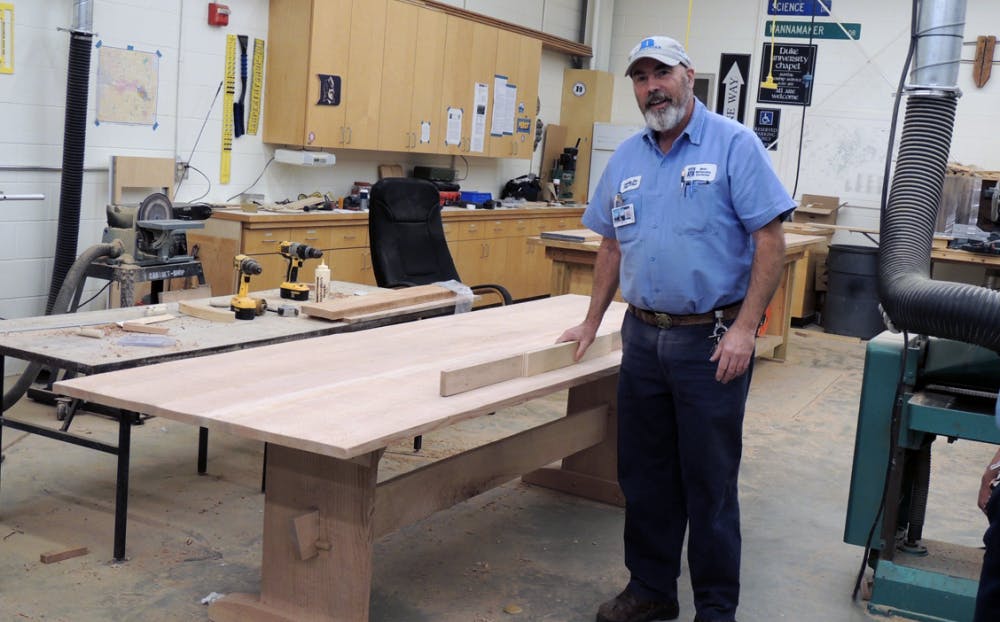Andy O’Shea has worked as a master carpenter in the facilities management department at Duke for more than two decades. A cabinetmaker and carpenter by trade, O’Shea has created some of Duke’s most unique pieces—tables and benches crafted from repurposed trees cut down across campus. The Chronicle’s Bre Bradham talked with O’Shea over the phone while sitting at the wooden table in the Giles' kitchen—one of O’Shea’s creations.
The Chronicle: How did you get started with carpentry, and how did you end up here at Duke?
Andy O’Shea: I started doing furniture work when I was about 20 years old, refinishing antique furniture. I did custom cabinetry, built houses and then I came to work here at Duke about 22 years ago. I contracted out here for a couple years. I’ve been working in the cabinet shop and the carpentry shop for about 22 years. They just recently have been cutting all these trees down and wanting to use them, that’s how I got into this.
TC: What have been some of your favorite projects with the reclaimed wood?
AO: I did a bench just recently, and we are actively talking with some people in facilities about increasing the scope of some projects in some buildings—maybe doing an entire room or something. Several buildings need to have the doors redone, so we are talking to them about possibly taking some of the wood harvested on campus and making the doors for the buildings.
Right now, I am doing another table that is a little bit different for facilities. I’m actually making a conference table, but it’s not out of this reclaimed wood. It’s out of some other wood that has been reclaimed.
TC: Where on campus are some of your other creations?
AO: Well. You’re familiar with the table in Giles. Really, the first one we did was about a year-and-a-half to two years ago, and that is the one in the Smart House. We did that one and a set of benches. I’m doing a bench right now for over at Keohane Dorm commons area. That’s really the three ones that we’ve done recently, but I’m hoping to do more. I would love to do more.
TC: How does this contrast with the work that you do on a daily basis?
AO: It gives me a little more freedom to use my artistic level, I guess. There’s something enjoyable about bringing something back that has intrinsic value to the University. You can see it going full-circle.
TC: Tell us about the process from when you get the reclaimed wood to your finished product. Is there anything different about working with the reclaimed wood and working with regular wood?
AO: Yeah, it is. It’s odd in some ways, but keeping a table in a "rough" state and not totally finished is in some ways harder. Generally, you take the lumber and bring it down to a nominal size. You make all the boards consistent in size and width and everything, before you start doing any kind of joining or things like that, and it makes the process a little more uniform. Whereas now, you are working with something that has differences in it that don’t allow you to do that, and at the same time you do not want to take out that character that is in it… I make the stuff, but the finish guys who paint it add the luster and life to it.
Normally, we do shelves. I’m actually in the maintenance department, but I’m one of the few in the facilities department that still does project work. I do a cabinet here, a cabinet there. They are usually an odd size because it is not easy to get one that is a 27-and-a-half-inch cabinet, or something. Of if someone wants to put something around something to disguise it. Sometimes it is just typical shelves. I also work in the carpentry department, so sometimes I just hang things in rooms. Every day it is not just the same thing. It adds a little spice to life.
TC: Is there anything that you hope that students get out of sitting at one of your tables or knowing that the table in their dorm was made from wood harvested on Duke’s campus?
AO: I mean, you see some of these big, big trees, and you see someone cut down these trees—but they have a lifespan. It serves multiple purposes, and I guess that’s a good rule for life in general. It’s what you leave behind sometimes. I think the students have a real appreciation for it. They like to see that it doesn’t go to waste.
Get The Chronicle straight to your inbox
Signup for our weekly newsletter. Cancel at any time.
Bre is a senior political science major from South Carolina, and she is the current video editor, special projects editor and recruitment chair for The Chronicle. She is also an associate photography editor and an investigations editor. Previously, she was the editor-in-chief and local and national news department head.
Twitter: @brebradham
Email: breanna.bradham@duke.edu

